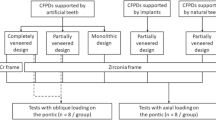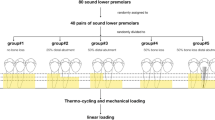Abstract
Objectives
The aim was to study the impact of the defect size of endodontically treated incisors compared to dental implants as abutments on the survival of zirconia two-unit anterior cantilever-fixed partial dentures (2U-FPDs) during 10-year simulation.
Materials and methods
Human maxillary central incisors were endodontically treated and divided into three groups (n = 24): I, access cavities rebuilt with composite core; II, teeth decoronated and restored with composite; and III as II supported by fiber posts. In group IV, implants with individual zirconia abutments were used. Specimens were restored with zirconia 2U-FPDs and exposed to two sequences of thermal cycling and mechanical loading. Statistics: Kaplan–Meier; log-rank tests.
Results
During TCML in group I two tooth fractures and two debondings with chipping were found. Solely chippings occurred in groups II (2×), IV (2×), and III (1×). No significant different survival was found for the different abutments (p = 0.085) or FPDs (p = 0.526). Load capability differed significantly between groups I (176 N) and III (670 N), and III and IV (324 N) (p < 0.024).
Conclusion
Within the limitations of an in vitro study, it can be concluded that zirconia-framework 2U-FPDs on decoronated teeth with/without post showed comparable in vitro reliability as restorations on implants. The results indicated that restorations on teeth with only access cavity perform worse in survival and linear loading.
Clinical relevance
Even severe defects do not justify per se a replacement of this particular tooth by a dental implant from load capability point of view.






Similar content being viewed by others
References
Fleming CH, Litaker MS, Alley LW, Eleazer PD (2010) Comparison of classic endodontic techniques versus contemporary techniques on endodontic treatment success. J Endod 36:414–418
Ng YL, Mann V, Rahbaran S, Lewsey J, Gulabivala K (2007) Outcome of primary root canal treatment: systematic review of the literature—part 1. Effects of study characteristics on probability of success. Int Endod J 40:921–939
Ng YL, Mann V, Rahbaran S, Lewsey J, Gulabivala K (2008) Outcome of primary root canal treatment: systematic review of the literature—part 2. Influence of clinical factors. Int Endod J 41:6–31
Goga R, Purton DG (2007) The use of endodontically treated teeth as abutments for crowns, fixed partial dentures, or removable partial dentures: a literature review. Quintessence Int 38:e106–e111
Kao RT (2008) Strategic extraction: a paradigm shift that is changing our profession. J Periodontol 79:971–977
Zitzmann NU, Krastl G, Hecker H, Walter C, Weiger R (2009) Endodontics or implants? A review of decisive criteria and guidelines for single tooth restorations and full arch reconstructions. Int Endod J 42:757–774
Zitzmann NU, Krastl G, Hecker H, Walter C, Waltimo T, Weiger R (2009) Strategic considerations in treatment planning: deciding when to treat, extract, or replace a questionable tooth. J Prosthet Dent 104:80–91
Schropp L, Wenzel A, Kostopoulos L, Karring T (2003) Bone healing and soft tissue contour changes following single-tooth extraction: a clinical and radiographic 12-month prospective study. Int J Periodontics Restorative Dent 23:313–323
Studer SP, Mader C, Stahel W, Scharer P (1998) A retrospective study of combined fixed-removable reconstructions with their analysis of failures. J Oral Rehabil 25:513–526
Garber DA, Salama MA, Salama H (2001) Immediate total tooth replacement. Compend Contin Educ Dent 22(210–216):218
Tymstra N, Raghoebar GM, Vissink A, Den Hartog L, Stellingsma K, Meijer HJ (2011) Treatment outcome of two adjacent implant crowns with different implant platform designs in the aesthetic zone: a 1-year randomized clinical trial. J Clin Periodontol 38:74–85
Salama H, Salama MA, Garber D, Adar P (1998) The interproximal height of bone: a guidepost to predictable aesthetic strategies and soft tissue contours in anterior tooth replacement. Pract Periodontics Aesthet Dent 10:1131–1141, quiz 1142
Tarnow D, Elian N, Fletcher P, Froum S, Magner A, Cho SC, Salama M, Salama H, Garber DA (2003) Vertical distance from the crest of bone to the height of the interproximal papilla between adjacent implants. J Periodontol 74:1785–1788
Holm-Pedersen P, Lang NP, Muller F (2007) What are the longevities of teeth and oral implants? Clin Oral Implants Res 18(Suppl 3):15–19
Iqbal MK, Kim S (2007) For teeth requiring endodontic treatment, what are the differences in outcomes of restored endodontically treated teeth compared to implant-supported restorations? Int J Oral Maxillofac Implants 22(Suppl):96–116
Torabinejad M, Anderson P, Bader J, Brown LJ, Chen LH, Goodacre CJ, Kattadiyil MT, Kutsenko D, Lozada J, Patel R, Petersen F, Puterman I, White SN (2007) Outcomes of root canal treatment and restoration, implant-supported single crowns, fixed partial dentures, and extraction without replacement: a systematic review. J Prosthet Dent 98:285–311
Salinas TJ, Eckert SE (2007) In patients requiring single-tooth replacement, what are the outcomes of implant- as compared to tooth-supported restorations? Int J Oral Maxillofac Implants 22(Suppl):71–95
Rosentritt M, Behr M, van der Zel JM, Feilzer AJ (2009) Approach for valuating the influence of laboratory simulation. Dent Mater 25:348–352
Rosentritt M, Siavikis G, Behr M, Kolbeck C, Handel G (2008) Approach for valuating the significance of laboratory simulation. J Dent 36:1048–1053
Naumann M, Preuss A, Frankenberger R (2007) Reinforcement effect of adhesively luted fiber reinforced composite versus titanium posts. Dent Mater 23:138–144
Sterzenbach G, Kalberlah S, Beuer F, Frankenberger R, Naumann M (2011) In-vitro simulation of tooth mobility for static and dynamic load tests: a pilot study. Acta Odontol Scand 69(5):316–318
Roulet JF, Van Meerbeek B (2007) Editorial: statistics: a nuisance, a tool, or a must? J Adhes Dent 9:287–288
Rosentritt M, Behr M, Gebhard R, Handel G (2006) Influence of stress simulation parameters on the fracture strength of all-ceramic fixed-partial dentures. Dent Mater 22:176–182
Naumann M, Preuss A, Rosentritt M (2006) Effect of incomplete crown ferrules on load capacity of endodontically treated maxillary incisors restored with fiber posts, composite build-ups, and all-ceramic crowns: an in vitro evaluation after chewing simulation. Acta Odontol Scand 64:31–36
Rosentritt M, Ries S, Kolbeck C, Westphal M, Richter EJ, Handel G (2009) Fracture characteristics of anterior resin-bonded zirconia-fixed partial dentures. Clin Oral Investig 13(4):453–457
Rosentritt M, Kolbeck C, Ries S, Gross M, Behr M, Handel G (2008) Zirconia resin-bonded fixed partial dentures in the anterior maxilla. Quintessence Int 39:313–319
Anusavice KJ, Kakar K, Ferree N (2007) Which mechanical and physical testing methods are relevant for predicting the clinical performance of ceramic-based dental prostheses? Clin Oral Implants Res Suppl 3:218–231
De Munck J, Vargas M, Van Landuyt K, Hikita K, Lambrechts P, Van Meerbeek B (2004) Bonding of an auto-adhesive luting material to enamel and dentin. Dent Mater 20:963–971
Sterzenbach G, Karajouli G, Naumann M, Peroz I, Bitter K (2011) Fiber post placement with core build-up materials or resin cements—an evaluation of different adhesive approaches. Acta Odontol Scand ahead of print
Barnes D, Gingell JC, George D, Adachi E, Jefferies S, Sundar VV (2010) Clinical evaluation of an all-ceramic restorative system: a 36-month clinical evaluation. Am J Dent 23:87–92
Abdul Salam SN, Banerjee A, Mannocci F, Pilecki P, Watson TF (2006) Cyclic loading of endodontically treated teeth restored with glass fibre and titanium alloy posts: fracture resistance and failure modes. Eur J Prosthodont Restor Dent 14:98–104
Stewart GP, Jain P, Hodges J (2002) Shear bond strength of resin cements to both ceramic and dentin. J Prosthet Dent 88:277–284
Ritter AV, Ghaname E, Pimenta LA (2009) Dentin and enamel bond strengths of dual-cure composite luting agents used with dual-cure dental adhesives. J Dent 37:59–64
Ohlmann B, Fickenscher F, Dreyhaupt J, Rammelsberg P, Gabbert O, Schmitter M (2008) The effect of two luting agents, pretreatment of the post, and pretreatment of the canal dentin on the retention of fiber-reinforced composite posts. J Dent 36:87–92
Aksornmuang J, Nakajima M, Foxton RM, Tagami J (2007) Mechanical properties and bond strength of dual-cure resin composites to root canal dentin. Dent Mater 23:226–234
Kern M, Sasse M (2011) Ten-year survival of anterior all-ceramic resin-bonded fixed dental prostheses. J Adhes Dent 13:407–410
Ohlmann B, Marienburg K, Gabbert O, Hassel A, Gilde H, Rammelsberg P (2009) Fracture-load values of all-ceramic cantilevered FPDs with different framework designs. Int J Prosthodont 22:49–52
Ghazy MH, Madina MM, Aboushelib MN (2012) Influence of fabrication techniques and artificial aging on the fracture resistance of different cantilever zirconia fixed dental prostheses. J Adhes Dent 14:161–166
Wolfart S, Harder S, Eschbach S, Lehmann F, Kern M (2009) Four-year clinical results of fixed dental prostheses with zirconia substructures (Cercon): end abutments vs. cantilever design. Eur J Oral Sci 117:741–749
Al-Amleh B, Lyons K, Swain M (2010) Clinical trials in zirconia: a systematic review. J Oral Rehabil 37:641–652
Rammelsberg P, Schwarz S, Schroeder C, Bermejo JL, Gabbert O (2012) Short-term complications of implant-supported and combined tooth-implant-supported fixed dental prostheses. Clin Oral Implants Res. doi:10.1111/j.1600-0501.2012.02482.x. [Epub ahead of print]
Bouillaguet S, Troesch S, Wataha JC, Krejci I, Meyer JM, Pashley DH (2003) Microtensile bond strength between adhesive cements and root canal dentin. Dent Mater 19:199–205
Lertchirakarn V, Palamara JE, Messer HH (2003) Patterns of vertical root fracture: factors affecting stress distribution in the root canal. J Endod 29:523–528
Feilzer AJ, De Gee AJ, Davidson CL (1987) Setting stress in composite resin in relation to configuration of the restoration. J Dent Res 66:1636–1639
Signore A, Benedicenti S, Kaitsas V, Barone M, Angiero F, Ravera G (2009) Long-term survival of endodontically treated, maxillary anterior teeth restored with either tapered or parallel-sided glass-fiber posts and full-ceramic crown coverage. J Dent 37:115–121
Torbjorner A, Fransson B (2004) A literature review on the prosthetic treatment of structurally compromised teeth. Int J Prosthodont 17:369–376
Pjetursson BE, Tan K, Lang NP, Bragger U, Egger M, Zwahlen M (2004) A systematic review of the survival and complication rates of fixed partial dentures (FPDs) after an observation period of at least 5 years. Clin Oral Implants Res 15:667–676
Bitter K, Noetzel J, Stamm O, Vaudt J, Meyer-Lueckel H, Neumann K, Kielbassa AM (2009) Randomized clinical trial comparing the effects of post placement on failure rate of postendodontic restorations: preliminary results of a mean period of 32 months. J Endod 35:1477–1482
Conflict of interest
The authors declare that they have no conflict of interest.
Author information
Authors and Affiliations
Corresponding author
Additional information
Naumann M. and Hohmann C. contributed equally to this manuscript
Rights and permissions
About this article
Cite this article
Naumann, M., Hohmann, C., Happe, A. et al. Are implants more reliable than severely compromised endodontically treated teeth as abutments for zirconia-based FPDs?. Clin Oral Invest 17, 1685–1692 (2013). https://doi.org/10.1007/s00784-012-0866-2
Received:
Accepted:
Published:
Issue Date:
DOI: https://doi.org/10.1007/s00784-012-0866-2




